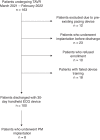Non-continuous mobile electrocardiogram monitoring for post-transcatheter aortic valve replacement delayed conduction disorders put to the test
- PMID: 36691737
- PMCID: PMC10062351
- DOI: 10.1093/europace/euac285
Non-continuous mobile electrocardiogram monitoring for post-transcatheter aortic valve replacement delayed conduction disorders put to the test
Abstract
Aims: Permanent pacemaker implantation (PPM-I) remains nowadays the most important drawback of transcatheter aortic valve replacement (TAVR) procedure and the optimal strategy of delayed conduction disturbances (CDs) in these patients is unclear. The study aimed to validate an ambulatory electrocardiogram (ECG) monitoring through a 30 s spot ambulatory digital mobile ECG (AeECG), by using KardiaMobile-6L device in a 30-day period after TAVR procedure.
Methods and results: Between March 2021 and February 2022, we consecutively enrolled all patients undergoing TAVR procedure, except pacemaker (PM) carriers. At discharge, all patients were provided of a KardiaMobile-6L device and a spot digital ECG (eECG) recording 1 month schedule. Clinical and follow-up data were collected, and eECG schedule compliance and recording quality were explored. Among 151 patients without pre-existing PM, 23 were excluded for pre-discharge PPM-I, 18 failed the KardiaMobile-6L training phase, and 10 refused the device. Delayed CDs with a Class I/IIa indication for PPM-I occurred in eight patients (median 6 days). Delayed PPM-I vs. non-delayed PPM-I patients were more likely to have longer PR and QRS intervals at discharge. PR interval at discharge was the only independent predictor for delayed PPM-I at multivariate analysis. The overall eECG schedule compliance was 96.5%. None clinical adverse events CDs related were documented using this new AeECG monitoring modality.
Conclusion: A strategy of 30 s spot AeECG is safe and efficacious in delayed CDs monitoring after TAVR procedure with a very high eECG schedule level of compliance.
Keywords: Delayed conduction disturbances; Handheld electrocardiogram; Mobile health; Transcatheter aortic valve replacement.
© The Author(s) 2023. Published by Oxford University Press on behalf of the European Society of Cardiology.
Conflict of interest statement
Conflict of interest: None declared.
Figures



Similar articles
-
The utility and impact of outpatient telemetry monitoring in post-transcatheter aortic valve replacement patients.Cardiovasc Revasc Med. 2024 Jul;64:15-20. doi: 10.1016/j.carrev.2024.02.012. Epub 2024 Feb 17. Cardiovasc Revasc Med. 2024. PMID: 38388248
-
Predictors of right ventricular pacing and pacemaker dependence in transcatheter aortic valve replacement patients.J Interv Card Electrophysiol. 2018 Jan;51(1):77-86. doi: 10.1007/s10840-017-0303-1. Epub 2017 Dec 19. J Interv Card Electrophysiol. 2018. PMID: 29260369
-
Permanent-temporary pacemakers in the management of patients with conduction abnormalities after transcatheter aortic valve replacement.J Interv Card Electrophysiol. 2018 Jun;52(1):111-116. doi: 10.1007/s10840-018-0345-z. Epub 2018 Mar 12. J Interv Card Electrophysiol. 2018. PMID: 29532275
-
Incidence, Predictors, and Implications of Permanent Pacemaker Requirement After Transcatheter Aortic Valve Replacement.JACC Cardiovasc Interv. 2021 Jan 25;14(2):115-134. doi: 10.1016/j.jcin.2020.09.063. JACC Cardiovasc Interv. 2021. PMID: 33478630 Review.
-
Clinical and Echocardiographic Outcomes Following Permanent Pacemaker Implantation After Transcatheter Aortic Valve Replacement: Meta-Analysis and Meta-Regression.Circ Cardiovasc Interv. 2017 Jul;10(7):e005046. doi: 10.1161/CIRCINTERVENTIONS.117.005046. Circ Cardiovasc Interv. 2017. PMID: 28698290 Review.
Cited by
-
Utility and acceptability of remote 6-lead electrocardiographic monitoring in children with inherited cardiac conditions.Arch Dis Child. 2024 Aug 16;109(9):742-747. doi: 10.1136/archdischild-2023-326756. Arch Dis Child. 2024. PMID: 38849195 Free PMC article.
References
-
- Grover FL, Vemulapalli S, Carroll JD, Edwards FH, Mack MJ, Thourani VHet al. . 2016 annual report of the Society of Thoracic Surgeons/American College of Cardiology transcatheter valve therapy registry. J Am Coll Cardiol 2017;69:1215–30. - PubMed
-
- Auffret V, Puri R, Urena M, Chamandi C, Rodriguez-Gabella T, Philippon Fet al. . Conduction disturbances after transcatheter aortic valve replacement: current Status and future perspectives. Circulation 2017;136:1049–69. - PubMed
-
- Ruck A, Saleh N, Glaser N. Outcomes following permanent pacemaker implantation after transcatheter aortic valve replacement: SWEDEHEART observational study. JACC Cardiovasc Interv 2021;14:2173–81. - PubMed
-
- van Rosendael PJ, Delgado V, Bax JJ. Pacemaker implantation rate after transcatheter aortic valve implantation with early and new-generation devices: a systematic review. Eur Heart J 2018;39:2003–13. - PubMed
-
- Fadahunsi OO, Olowoyeye A, Ukaigwe A, Li Z, Vora AN, Vemulapalli Set al. . Incidence, predictors, and outcomes of permanent pacemaker implantation following transcatheter aortic valve replacement: analysis from the U. S. Society of Thoracic Surgeons/American College of Cardiology TVT registry. JACC Cardiovasc Interv 2016;9:2189–99. - PubMed
MeSH terms
LinkOut - more resources
Full Text Sources
Medical
Research Materials

